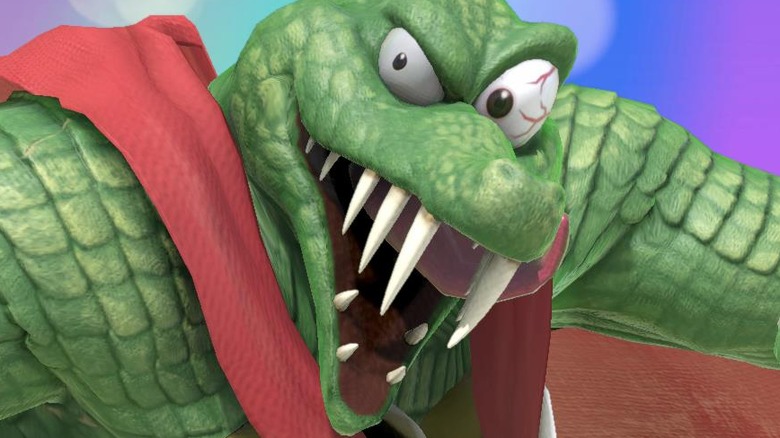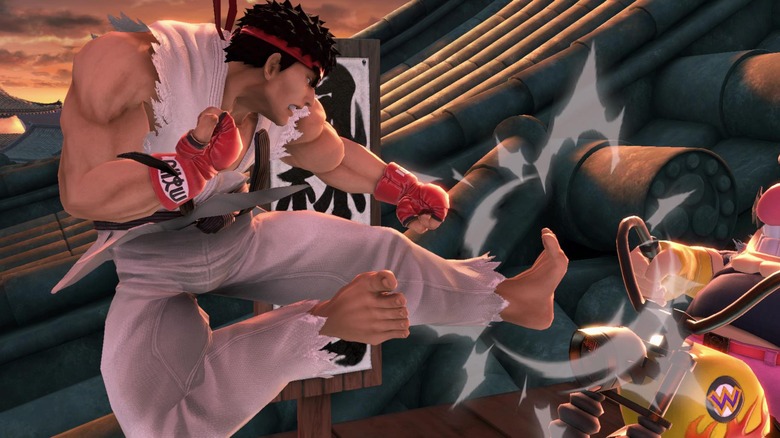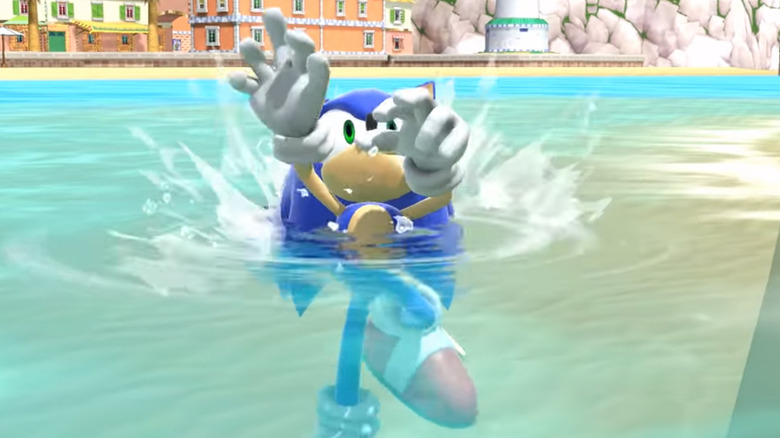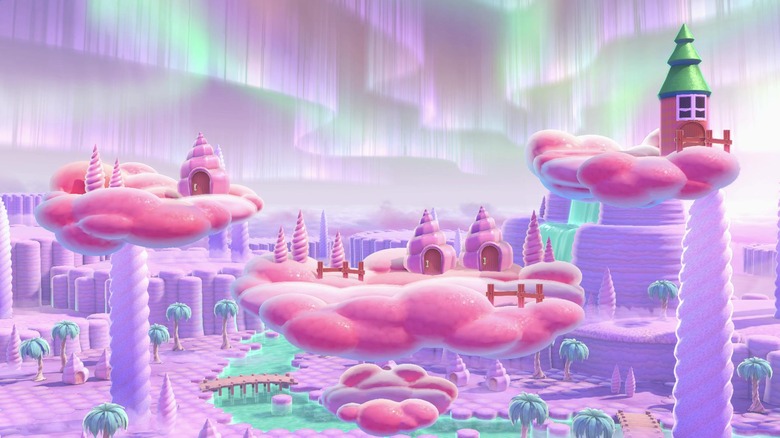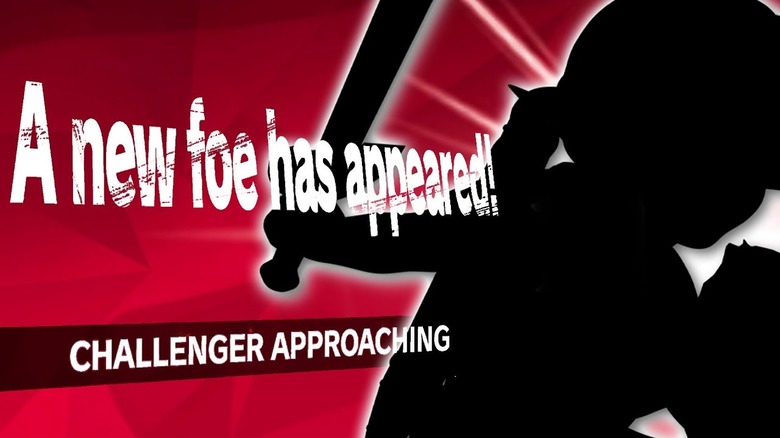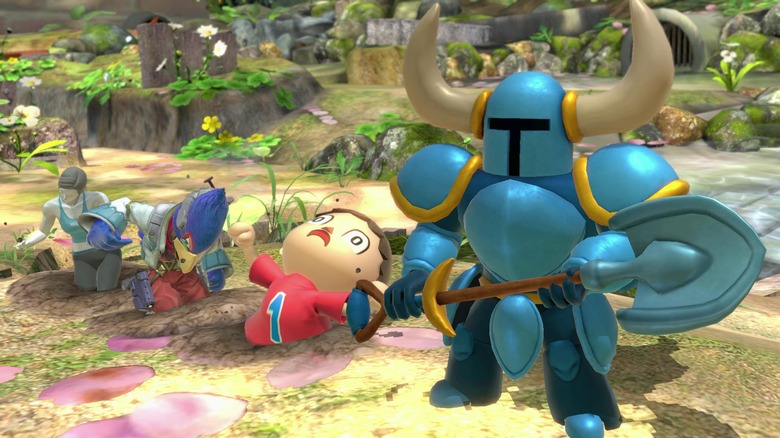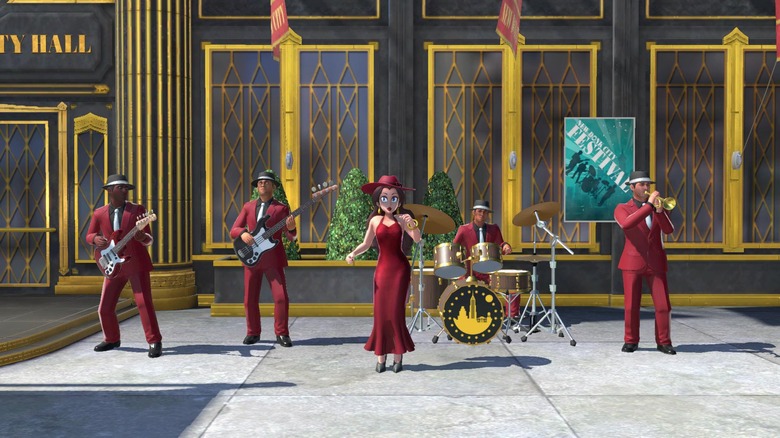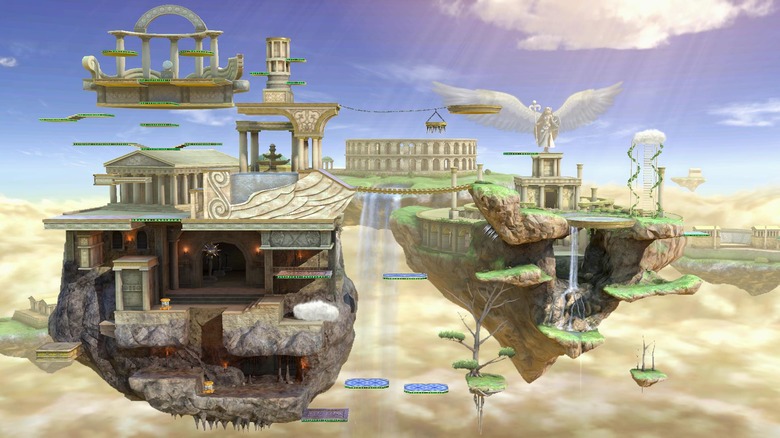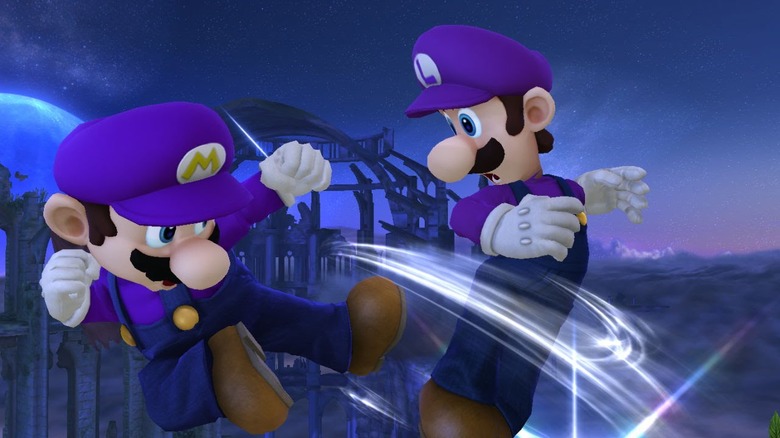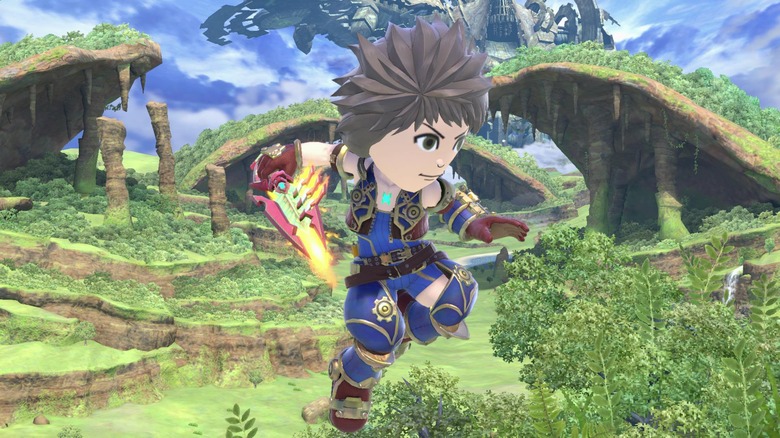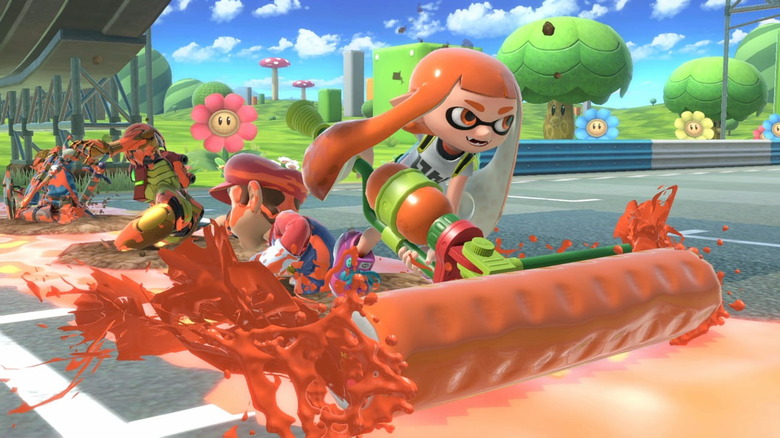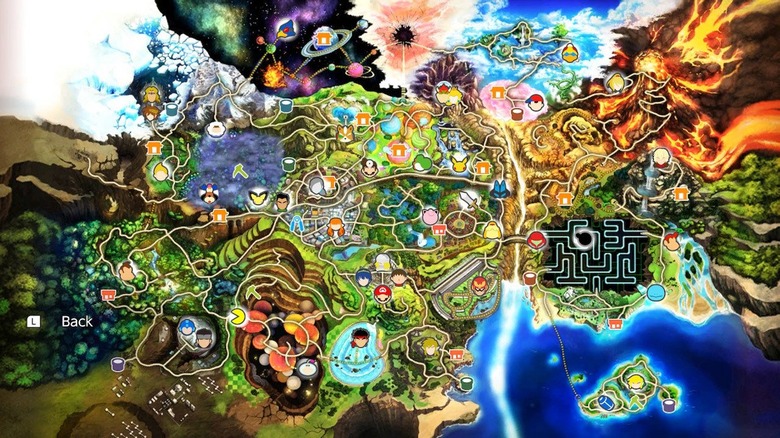Small Details You Missed In Super Smash Bros. Ultimate
Super Smash Bros. Ultimate lives up to its name. Nintendo's latest iteration of their mega-popular mascot brawler isn't just the biggest, most complete version of Smash Bros. ever released. It doesn't just have more fighters, more stages, and more music than any Smash Bros. game that came before it. It's also one of the largest, most in-depth platforms for fanservice ever created. Forget Avengers: Infinity War. Super Smash Bros. Ultimate is the actual most ambitious crossover event in history.
You can't play Super Smash Bros. Ultimate for more than a minute without stumbling across some kind of Easter egg, allusion or reference, but if you want to catch 'em all, you'll need to pay attention. Many of Super Smash Bros. Ultimate's most interesting details are subtle, and the game has so much going on that you're bound to miss a few.
Don't worry. We're here to help. The following tidbits aren't Super Smash Bros. Ultimate's flashiest nods to Nintendo's storied past, but they go a long way towards making SSBU the phenomenon that it is. After all, director Masahiro Sakurai and his crew are famous for their attention to detail, and Super Smash Bros. Ultimate is all the better for it.
Every Classic Mode line-up tells a story
If you're not squeezing onto the couch to play Super Smash Bros. Ultimate against friends, venturing online to challenge fighters around the world, or gathering spirits in World of Light, you're probably spending most of your Smash sessions in Classic Mode. That's not new. Classic Mode has been there since the very first Super Smash Bros. game. It's not going anywhere.
But you've never seen Classic Mode quite like this. From Melee on, Classic Mode pitted players against a random or branching selection of opponents. Super Smash Bros. Ultimate does things differently. In Ultimate, every character — yes, all 74 of them — faces off against a unique line-up of opponents. Even better, most of those lineups are themed around the starring character. Fire Emblem hero Marth, for example, is a famous dragon hunter, so Classic Mode puts him up against characters like Bowser and Ridley. Princess Peach gets to knock the stuffing out of would-be kidnappers like Ganondorf and Donkey Kong, while the Ice Climbers challenge other famous gaming duos.
None of these mini-campaigns are quite as impressive as Ryu's, however, which is basically a complete Street Fighter game in Smash Bros. form. Characters like Zero Suit Samus and Meta Knight stand in for world warriors like Chun-Li and Vega, complete with the appropriate theme music. Ryu's Classic Mode fights are all Stamina Battles, mimicking Street Fighter's life bar. Street Fighter V might remain a PS4 and PC exclusive, but if you're a Switch owner, it hardly matters. Super Smash Bros. Ultimate is the next-best thing.
The itsy bitsy hedgehog climbed up the water spout...
The Smash Bros. franchise puts a lot of value in authenticity. It's not enough for a character to be popular. If they're going to show up in Super Smash Bros., director Masahiro Sakurai and his team want to make sure that they play as close to the real thing as possible. That's why characters like Tekken's Heihachi isn't on the Super Smash Bros. roster. Sakurai decided that the way that Heihachi moves wouldn't translate well to Smash, and instead of diluting the character's essence to get him in the game anyway, he cut the character entirely.
You can see that attention to detail pop up in the characters that did make the roster, too. Case in point: if a character can't swim in their own games, they won't be too fond of water in SSBU, either. As Kotaku observes, the fire-based Pokémon Charizard and Incineroar, Splatoon's Inklings, and Sonic the Hedgehog are all water-averse (in Sonic's case, because his creator mistakenly thought that hedgehogs can't swim) in their original titles. In Super Smash Bros. Ultimate, they'll take damage when submerged, even if they're not drowning quite yet.
It's a subtle touch, but it's indicative of the kind of love and attention that's made Smash Bros. a hit among casual players. Lots of games do fanservice, but none of them do it quite like Super Smash Bros., and the franchise is all the better for it.
A picture is worth a thousand words (and at least one Easter egg)
True to its name, Super Smash Bros. Ultimate is packed full of more Easter eggs, references, and subtle nods to video games of the past than any Smash Bros. before it, and they're not all hidden in plain sight. If you want to uncover all of the secrets that Super Smash Bros. Ultimate is hiding, you'll need to look off the beaten path — and sometimes outside of the bounds of the stage itself.
You can do that by entering Super Smash Bros. Ultimate's photo mode, which lets you tilt, angle, and zoom the in-game camera in order to reveal hidden parts of each level. For example, in the Earthbound-inspired Magicant stage, you can occasionally find the anthropomorphic dungeon known as Dungeon Man walking across the bottom of the level. Well, if you pause the game and zoom into Dungeon Man's eye hole, you'll find another surprise. Brick Road, the man who built the dungeon, is stuck inside its walls, as befits the self-proclaimed "first fusion of Man and Dungeon."
Rumors suggest that Brick Road's final form isn't the only Easter egg hidden off-screen in Super Smash Bros. Ultimate's various levels, either, so start looking — and plan on searching for a while. Super Smash Bros. Ultimate has over 100 levels, each of which comes in three different forms. That's a lot of space to hide Easter eggs, and we're pretty sure that Sakurai and company used all of it. Good luck. You're going to need it.
Approaching challengers so nice you can fight 'em twice
Super Smash Bros. Ultimate comes with a ton of characters — 69 of 'em, in fact, not counting the clone-like "Echo Fighters" or future pieces of DLC — but when you first boot up the game, your roster is very, very limited. At the beginning, you'll only be able to play as one of the franchise's original eight characters. You'll need to earn everyone else yourself.
Thankfully, there are many ways to unlock new characters. You can earn new characters by playing through Super Smash Bros. Ultimate's single-player campaign, World of Light, you can get them by playing through Classic Mode, or you can simply spend 10 minutes fighting in matches. Be careful, however — every time that a new challenger appears, you'll need to beat them in a one-on-one battle before they join your roster. In Ultimate, the computer's AI has received a major upgrade. Some of these fights are tough.
If you lose one of these "challenger approaching" battles, however, you won't have to wait too long for a rematch. Occasionally, a door labeled Challenger's Approach appears on the Games & More menu. Opening it will let you fight all of those characters that beat you before, giving you another shot at unlocking them permanently. Challenger's Approach is easy to miss, and it appears somewhat randomly (the more fighters you have waiting in the wings, the more frequently it pops up), so keep a steady watch. Unlocking the full Super Smash Bros. Ultimate roster already takes long enough. Any and every shortcut is very, very welcome.
AAA or indie, it doesn't matter — the gang's all here!
Over the years, Super Smash Bros. has transformed from a Nintendo crossover into a gushing love letter to video games everywhere, regardless of publisher. Sure, the big N still gets most of the attention, but Super Smash Bros. Ultimate also has characters from Castlevania, Metal Gear Solid, Street Fighter, Final Fantasy, Sonic the Hedgehog, and more. If it has appeared on a Nintendo console — and, in a few cases, even if it hasn't — chances are it's in Super Smash Bros. Ultimate, too.
For the most part, however, Super Smash Bros. has focused on big-budget titles from major studios. Not any more. In Super Smash Bros. Ultimate, indie developers are getting some love, too. Back in 2015, Yacht Club Games' Shovel Knight got his own amiibo figurine, and now he's been immortalized in SSBU as one of the game's assist trophies. He's not alone, either. WayForward Technologies' hair-flinging genie, Shantae, is in the game as one of 1,300 ability-granting spirits, too.
Could more indie stars be on the way? Maybe. As of this writing, the identities of Super Smash Bros. Ultimate's final four DLC characters has yet to be revealed, and if Persona 5's Joker is on the table, then pretty much anything is possible. We'll just have to wait and see.
The sweet sound of secrets
Super Smash Bros. Ultimate doesn't just look great. It sounds great, too. Not only does Super Smash Bros. Ultimate contain new auditory tricks like New Donk City's interactive soundtrack, but the game is packed with over 800 classic video tunes, including a number of high-quality covers and re-recordings. You don't even need to play Super Smash Bros. Ultimate in order to enjoy them. By using SSBU's "Sound Test" mode, you can listen to your favorite tracks with your Switch's screen turned off. It's like having your own, portable, video game-themed jukebox. It's great.
While you're rocking out, don't forget to pay attention. As you might expect, you'll find a few cool details hidden in Super Smash Bros. Ultimate's music player. When you've got a song set to repeat, for example, it doesn't just restart when it's done. It'll actually revert back to an earlier point in the track, creating an unbroken loop for your listening pleasure. The "King Bowser" track contains an obscure melody from Super Mario RPG: Legend of the Seven Stars. The second half of the "Final Destination" theme is actually the game's main theme played backwards.
With so many songs on Super Smash Bros. Ultimate's soundtrack, that's probably just the tip of the iceberg, too, so listen carefully. There's no telling what else you'll find.
If you're lost, let Palutena guide you
Palutena's Guidance isn't a new feature in Super Smash Bros. Ultimate. It debuted in Super Smash Bros. for Wii U (also known as Smash 4), and it's a lot of fun. If you're playing as Kid Icarus star Pit and happen to find yourself fighting at Palutena's Temple, press the down taunt button. Palutena and Pit (and, occasionally, Kid Icarus: Uprising's Viridi) will launch into conversations about Pit's on-screen rivals. The Kid Icarus stars will share a little bit of the character's history and backstory, give you a couple of hints about how to beat them, and cap things off with an endearingly corny joke or comedy routine.
It's basically the same thing as Solid Snake's codec conversations, but there's one big difference. While voice actor David Hayter didn't record any new lines as Snake (meaning that the cloned superspy doesn't have anything to say about characters who weren't in Super Smash Bros. Brawl), Palutena shares insights about everyone on Super Smash Bros. Ultimate's roster.
Given that Ultimate has more characters than any other Smash Bros. game to date, that means there's a whole lot of new material to enjoy. Curious to see what Angel Land's citizens have to say about characters who missed Smash 4, like Star Fox's Wolf, or newcomers like Castlevania hunk Simon Belmont? Just choose Pit, fly over to Palutena's Temple, and find out for yourself.
Expand the roster with a little color
Even with the largest roster in Super Smash Bros. history, not every fan-favorite character made it into Super Smash Bros. Ultimate, at least not as a playable personality. Waluigi, for example, remains one of the most-wanted Super Smash Bros. characters, but much to his fans' chagrin, he only appears in Ultimate as a computer-controlled assist trophy.
If you're willing to use your imagination, however, you can play as Waluigi anyway — sort of. As in previous games, Super Smash Bros. Ultimate characters have a bunch of different outfits — eight per character, in SSBU — and many of these color swaps and alternate outfits contain nods to characters that didn't quite make the cut. Choosing between them is simple, too. When you're choosing your character, use the left and right shoulder buttons to cycle through all of the available outfits. It's that easy.
So, no, you still can't nab Waluigi on the character select screen, but if you give Luigi purple duds, you can certainly pretend. Same goes for Meta Knight's purple Galacta Knight get-up and Inceneroar's Big the Cat-inspired color scheme. Some of the alternate outfits go even further, too. Want to play as a hand-crafted dinosaur from Yoshi's Wooly World or one of the Koopa kids? Super Smash Bros. Ultimate has you covered.
It's all about Mii
Maybe you've got a favorite character who, somehow, still isn't in Super Smash Bros. Ultimate, and who isn't covered by the outfits in the main roster's wardrobe. Well, don't forget about the Mii Brawler, the Mii Swordfighter, and the Mii Gunner, who can be customized to take the place of almost any video game character — or, really, anyone — that you can dream of. Unlike other characters, you don't even have to unlock them. They're easy to miss, but they're in there — go to the "Games & More" menu, select Mii Fighters, and create your character. After you save, they'll show up on the character select screen. No muss, no fuss.
In addition, you can earn Mii Fighter clothing by playing Super Smash Bros. Ultimate and by spending in-game gold in the store, and many of the pieces let you dress your character up like established characters. In Super Smash Bros., Toad usually serves as Princess Peach's hapless shield, but Mii costumes allow you to fight with him on the front lines. The same goes for Super Mario RPG's doll-turned-cosmic-entity Geno, ARMS fighters Ribbon Girl and Spring Man, Animal Crossing's resident musician K. K. Slider, and more.
With a little work, you can even create non-Nintendo characters, or even people from movies, comics, and TV. A bald head, a suit, and a briefcase all come together to create Hitman star Agent 47. Long blond hair and the tracksuit will get you a pretty good copy of Uma Thurman's Bride from Kill Bill. With Mii Fighters, your imagination is the only real limit, so go wild. You won't regret it.
More than just a nostalgia act
Super Smash Bros. Ultimate came out a paltry four years after Super Smash Bros. for 3DS and Wii U, but Nintendo has been through many, many changes since then. It launched a new console. Its two biggest series, Super Mario Bros. and The Legend of Zelda, both received new, franchise-defining entries in Super Mario Odyssey and Breath of the Wild. Series like Splatoon breathed quirky new life into Nintendo's already eclectic lineup. Nintendo Labo, which uses cardboard to make the Switch into all kinds of physical, programmable toys, launched to excellent reviews.
Well, guess what? All of those modern updates made their way into Super Smash Bros. Ultimate, too. Link received the most obvious changes — in SSBU, his default outfit is his blue Breath of the Wild tunic, and his down-special bombs are now BotW's remote explosives — but there's plenty of love to go around. Sheik's new outfit is based on Breath of the Wild's stealth armor (which was, in turn, based on Sheik's original design). Mario's body-stealing hat, Cappy, appears during the plumber's up-special attack, and his snazzy white wedding outfit pops up as an alternate costume.
As far as new properties are concerned, well, Mii Brawlers can don a Labo headset. The Splatoon kids look like they're based on the designs from the first game rather than its Switch-set sequel, but the fact that they're in the game at all — as main characters, even — is a sign that Super Smash Bros. Ultimate isn't just a sprawling tribute to Nintendo's past. It's got an eye on the company's future, as well.
Next stop, Nintendo City!
Apparently, filling Super Smash Bros. Ultimate with the biggest, most famous, and most popular characters in Nintendo's history didn't fill the game's fanservice quota. Cramming more classic Nintendo tunes into the game than any sane person could possibly want (seriously, who really needs 10 different tracks from Wii Fit? Anyone?) didn't get the job done, either. Over 1,300 spirits representing characters both beloved and almost entirely unknown? Over 100 stages, almost every single one of which is full of nods, references, and Easter eggs? Sorry. It's just not enough.
No, in order to cap off Super Smash Bros. Ultimate's overwhelming tribute to everything Nintendo, Masahiro Sakurai and the Super Smash Bros. team went the extra mile and constructed an entire city out of old Nintendo consoles. Look carefully at the map in World of Light, SSBU's single-player adventure. You'll find buildings constructed from an original Famicom console, the old-school Game Boy, a GameCube, a Wii, part of a Super NES controller, and more. Even the Japan-only Famicom Disk System — or at least its mascot — makes a cameo.
In other words, Sakurai and company built a place where every era of Nintendo's long and eventful history gets mashed up, crammed together, and emerges as one glorious, Easter egg-filled whole. Sound familiar? That's basically Super Smash Bros. in a nutshell. It's hard to imagine a better metaphor for the franchise than a literal Nintendo city, but give Sakurai time. If another Smash Bros. ever rolls around, we're sure he'll think of something.

